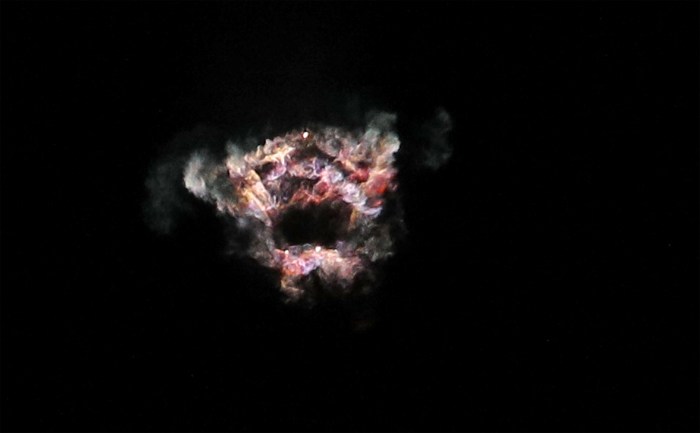_
Join us as we take a look at the best photos from a new SpaceX launch carrying a moon lander mission…
The solid rocket booster stage separates from the SpaceX Falcon 9 rocket about three minutes after liftoff from the Kennedy Space Center in Cape Canaveral, Florida, on the Intuitive Machines' Nova-C moon lander mission on Feb. 15, 2024.
The IM-1 mission — also known as Odysseus — is part of NASA's Commercial Lunar Payload Services (CLPS) program to understand more about the moon's surface ahead of the coming Artemis missions.
On Feb. 22, Intuitive Machines' Odysseus lander became the first U.S. spacecraft to land on the moon in more than 50 years when it touched down near the south pole of the moon on Feb. 22.
Keep reading for more…
MORE: Follow Wonderwall on MSN for more fun celebrity & entertainment photo galleries and content
_
Odysseus passes over the near side of the moon following lunar orbit insertion on Feb. 21, 2024.
MORE: Follow Wonderwall on MSN for more fun celebrity & entertainment photo galleries and content
_
A SpaceX Falcon 9 rocket lifts off from launch pad LC-39A at the Kennedy Space Center with the Intuitive Machines' Nova-C moon lander mission in Cape Canaveral, Florida, on Feb. 15, 2024. The IM-1 mission is part of NASA's Commercial Lunar Payload Services (CLPS) program to understand more about the moon's surface ahead of the coming Artemis missions. Intuitive Machines' Odysseus lander would be the first U.S. spacecraft to land on the moon in more than 50 years. It is expected to land near the south pole of the moon on Feb. 22.
MORE: Follow Wonderwall on MSN for more fun celebrity & entertainment photo galleries and content
_
A SpaceX Falcon 9 rocket soars into orbit after launching from the Kennedy Space Center in Cape Canaveral, Florida, on Feb. 15, 2024, on the Intuitive Machines' Nova-C moon lander mission. The IM-1 mission is part of NASA's Commercial Lunar Payload Services (CLPS) program to understand more about the moon's surface ahead of the coming Artemis missions. Intuitive Machines' Odysseus lander would be the first U.S. spacecraft to land on the moon in more than 50 years. It is expected to land near the south pole of the moon on Feb. 22.
_
An infographic titled "Spacecraft makes 1st US moon landing in more than 50 years" created in Istanbul, Turkey, on Feb. 23, 2024 shows how the Odysseus lander made its way to the moon's surface. Odysseus became the first U.S. spacecraft in more than a half century to land on the moon.
_
The solid rocket booster presents a fiery spectacle as it separates from the SpaceX Falcon 9 rocket about three minutes after liftoff from the Kennedy Space Center in Cape Canaveral, Florida, on the Intuitive Machines' Nova-C moon lander mission on Feb. 15, 2024. The IM-1 mission is part of NASA's Commercial Lunar Payload Services (CLPS) program to understand more about the moon's surface ahead of the coming Artemis missions. Intuitive Machines' Odysseus lander would be the first U.S. spacecraft to land on the moon in more than 50 years. It is expected to land near the south pole of the moon on Feb. 22.
_
Following a one-day delay due to a technical issue, a SpaceX Falcon 9 rocket carrying the Nova-C lander for the IM-1 mission launches from pad 39A at the Kennedy Space Center in Cape Canaveral, Florida, at 1:05 a.m. EDT on Feb. 15, 2024. The lander, built by Intuitive Machines, will attempt to deliver science payloads to the surface of the moon for NASA's Commercial Lunar Payload Services program.
_
A SpaceX Falcon 9 rocket lifts off from launch pad LC-39A at the Kennedy Space Center with the Intuitive Machines' Nova-C moon lander mission in Cape Canaveral, Florida, on Feb. 15, 2024. The IM-1 mission is part of NASA's Commercial Lunar Payload Services (CLPS) program to understand more about the moon's surface ahead of the coming Artemis missions. Intuitive Machines' Odysseus lander would be the first U.S. spacecraft to land on the moon in more than 50 years. It is expected to land near the south pole of the moon on Feb. 22.
_
The solid rocket booster separates from the SpaceX Falcon 9 rocket about three minutes after liftoff from the Kennedy Space Center in Cape Canaveral, Florida, on the Intuitive Machines' Nova-C moon lander mission on Feb. 15, 2024. The IM-1 mission is part of NASA's Commercial Lunar Payload Services (CLPS) program to understand more about the moon's surface ahead of the coming Artemis missions. Intuitive Machines' Odysseus lander would be the first U.S. spacecraft to land on the moon in more than 50 years. It is expected to land near the south pole of the moon on Feb. 22.
_
A SpaceX Falcon 9 rocket lifts off from launch pad LC-39A at the Kennedy Space Center with the Intuitive Machines' Nova-C moon lander mission in Cape Canaveral, Florida, on Feb. 15, 2024. The IM-1 mission is part of NASA's Commercial Lunar Payload Services (CLPS) program to understand more about the moon's surface ahead of the coming Artemis missions. Intuitive Machines' Odysseus lander would be the first U.S. spacecraft to land on the moon in more than 50 years. It is expected to land near the south pole of the moon on Feb. 22.
_
A SpaceX Falcon 9 rocket lifts off from launch pad LC-39A at the Kennedy Space Center with the Intuitive Machines' Nova-C moon lander mission in Cape Canaveral, Florida, on Feb. 15, 2024. The IM-1 mission is part of NASA's Commercial Lunar Payload Services (CLPS) program to understand more about the moon's surface ahead of the coming Artemis missions. Intuitive Machines' Odysseus lander would be the first U.S. spacecraft to land on the moon in more than 50 years. It is expected to land near the south pole of the moon on Feb. 22.
_
A SpaceX Falcon 9 rocket soars into orbit after launching from the Kennedy Space Center in Cape Canaveral, Florida, on Feb. 15, 2024, on the Intuitive Machines' Nova-C moon lander mission. The IM-1 mission is part of NASA's Commercial Lunar Payload Services (CLPS) program to understand more about the moon's surface ahead of the coming Artemis missions. Intuitive Machines' Odysseus lander would be the first U.S. spacecraft to land on the moon in more than 50 years. It is expected to land near the south pole of the moon on Feb. 22.
_
Following a one-day delay due to a technical issue, a SpaceX Falcon 9 rocket carrying the Nova-C lander for the IM-1 mission launches from pad 39A at the Kennedy Space Center in Cape Canaveral, Florida, at 1:05 a.m. EDT on Feb. 15, 2024. The lander, built by Intuitive Machines, will attempt to deliver science payloads to the surface of the moon for NASA's Commercial Lunar Payload Services program.
_
Following a one-day delay due to a technical issue, a SpaceX Falcon 9 rocket carrying the Nova-C lander for the IM-1 mission launches from pad 39A at the Kennedy Space Center in Cape Canaveral, Florida, at 1:05 a.m. EDT on Feb. 15, 2024. The lander, built by Intuitive Machines, will attempt to deliver science payloads to the surface of the moon for NASA's Commercial Lunar Payload Services program.
_
A SpaceX Falcon 9 rocket lifts off from launch pad LC-39A at the Kennedy Space Center with the Intuitive Machines' Nova-C moon lander mission in Cape Canaveral, Florida, on Feb. 15, 2024.
The IM-1 mission is part of NASA's Commercial Lunar Payload Services (CLPS) program to understand more about the moon's surface ahead of the coming Artemis missions.
Intuitive Machines' Odysseus lander would be the first U.S. spacecraft to land on the moon in more than 50 years. It is expected to land near the south pole of the moon on Feb. 22.
_
Following a one-day delay due to a technical issue, a SpaceX Falcon 9 rocket carrying the Nova-C lander for the IM-1 mission launches from pad 39A at the Kennedy Space Center in Cape Canaveral, Florida, at 1:05 a.m. EDT on Feb. 15, 2024. The lander, built by Intuitive Machines, will attempt to deliver science payloads to the surface of the moon for NASA's Commercial Lunar Payload Services program.
_
The solid rocket booster presents a fiery spectacle as it separates from the SpaceX Falcon 9 rocket about three minutes after liftoff from the Kennedy Space Center in Cape Canaveral, Florida, on the Intuitive Machines' Nova-C moon lander mission on Feb. 15, 2024. The IM-1 mission is part of NASA's Commercial Lunar Payload Services (CLPS) program to understand more about the moon's surface ahead of the coming Artemis missions. Intuitive Machines' Odysseus lander would be the first U.S. spacecraft to land on the moon in more than 50 years. It is expected to land near the south pole of the moon on Feb. 22.
_
Following a one-day delay due to a technical issue, a SpaceX Falcon 9 rocket carrying the Nova-C lander for the IM-1 mission launches from pad 39A at the Kennedy Space Center in Cape Canaveral, Florida, at 1:05 a.m. EDT on Feb. 15, 2024.
The lander, built by Intuitive Machines, will attempt to deliver science payloads to the surface of the moon for NASA's Commercial Lunar Payload Services program.
_
A SpaceX Falcon 9 rocket soars into orbit from the Kennedy Space Center on the Intuitive Machines' Nova-C moon lander mission in Cape Canaveral, Florida, on Feb. 15, 2024. The IM-1 mission is part of NASA's Commercial Lunar Payload Services (CLPS) program to understand more about the Moon's surface ahead of the coming Artemis missions. Intuitive Machines' Odysseus lander would be the first US spacecraft to land on the moon in over 50 years. It is expected to land near the south pole of the moon on Feb. 22.
_
Following a one-day delay due to a technical issue, a SpaceX Falcon 9 rocket carrying the Nova-C lander for the IM-1 mission launches from pad 39A at the Kennedy Space Center in Cape Canaveral, Florida, on Feb. 15, 2024.
The lander built by Intuitive Machines will attempt to deliver science payloads to the surface of the moon for NASA's Commercial Lunar Payload Services program.
_
A pelican lounges along the Turning Basin at the Kennedy Space Center in Cape Canaveral, Florida, on Feb. 13, 2024, while in the distance, a SpaceX Falcon 9 rocket sits ready for the Intuitive Machines' Nova-C moon lander mission at launch pad LC-39A two days before blasting off carrying Intuitive Machines' Nova-C moon lander mission.






















